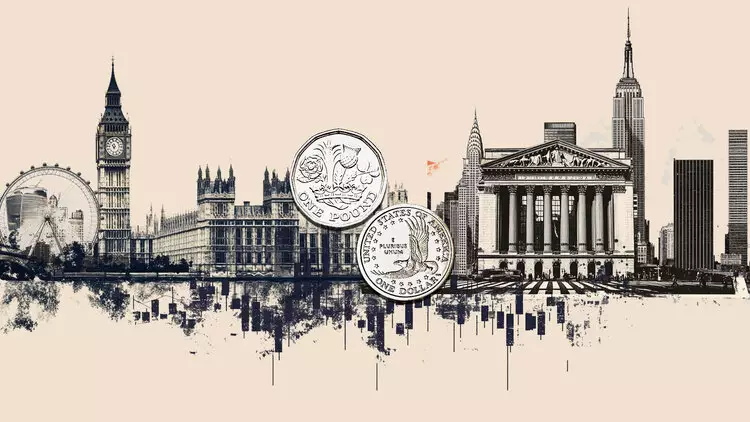In a market landscape fraught with ambiguity and geopolitical turbulence, the GBP/USD pair is carving out a modest yet noteworthy upward trajectory. Climbing approximately 0.07%, the currency pair navigates through a complex web of economic indicators, political developments, and shifting market sentiment. The current trading level around 1.3305 belies the undercurrents of tension and opportunity that characterize today’s forex environment. This nuanced movement is emblematic of a broader trend: in times of uncertainty, the market often exhibits a cautious resilience, with currencies testing key support and resistance levels rather than embarking on aggressive moves.
The recent uptick in GBP/USD reflects a delicate balancing act. On one side, the U.S. dollar shows signs of vulnerability, weighed down by disappointing economic data and questions surrounding the credibility of upcoming releases. On the other, the British pound’s trajectory appears influenced by expectations of a potential rate cut by the Bank of England and a weakening services sector. The interplay of these factors fuels a cautious optimism among traders, who are simultaneously wary of further surprises.
Diverging Economic Narratives: US vs. UK
US economic indicators have painted a somewhat puzzling picture. The ISM Services PMI declined to 50.1 from 50.8 in June, below forecasts of 51.6. Such a dip signals a deceleration in service sector activity, which is a key component of the American economy. Meanwhile, positive trade figures—specifically, a nearly two-year low in the trade deficit—offer a glimmer of optimism. However, these mixed signals generate doubt about the strength and sustainability of the US economic recovery. Traders are questioning whether the softening service sector presages a deeper slowdown or remains a temporary blip.
Adding fuel to the fire are political developments that shake confidence in the reliability of US economic data. The removal of the head of the Bureau of Labor Statistics and the resignation of Federal Reserve Governor Adriana Kugler have sparked concerns about the independence of data sources and the integrity of future releases. President Trump’s comments dismissing Scott Bessent’s potential nomination as Fed Chair further contribute to a climate of uncertainty. Such political noise breeds skepticism about the Fed’s ability to execute a stable monetary policy, which in turn influences dollar behavior.
Across the Atlantic, the UK economy faces its own challenges. The S&P Global Services PMI slipped to 51.8 from 52.8, driven mostly by a decline in new orders—the sharpest since November 2022. This slowdown reflects ongoing fragility in the UK’s crucial service sector, casting doubt on the resilience of the British economy. Market expectations are now heavily focused on the upcoming Bank of England (BoE) policy decision, anticipated to signal a rate cut to 4%. The market’s confidence in a dovish stance is high, with odds at 90%, implying that monetary easing is the consensus view among traders.
Market Dynamics and Technical Outlook
From a technical perspective, GBP/USD appears poised for consolidation, attempting to find a middle ground amid volatile fundamental signals. The pair’s resistance hover around 1.3330—a recent high on August 4—and the 100-day simple moving average near 1.3369. These levels act as psychological barriers, preventing the pound from ascending further in the short term. Conversely, downside support is anchored around the 1.3300 mark, with a critical breach exposing a potential slide toward 1.3141, the August 1 cycle low.
Despite the Relative Strength Index (RSI) nudging upward, the fact that it remains below the neutral line suggests a cautious stance. Any upticks should be treated skeptically, as traders could interpret them as opportunities for short-side entries. The market’s delicate look hints at a period of sideways trading—an environment where patience and selective positioning could prove to be prudent.
Furthermore, the pound has demonstrated relative strength against certain currencies, notably the Swiss Franc, indicating localized market disparities. This performance hints at underlying regional tensions influencing currency flows, with investors seeking refuge or risk depending on evolving geopolitical queries.
The Broader Implication: A Balanced but Fragile Outlook
This intricate dance of currencies underscores a broader truth: in times of global economic and political unpredictability, stability remains elusive. The GBP/USD pair exemplifies this reality, as traders digest an array of conflicting signals—softening US data, prospective UK rate cuts, political upheavals, and external shocks. Each element feeds into a market atmosphere that remains highly susceptible to sudden shifts, where directional bias must be balanced with heightened vigilance.
In essence, GBP/USD’s current modest gains are less a sign of robust strength and more a reflection of a market nervously testing resistance levels. It underscores the importance of nuance in trading decisions, where context and technical signals must be read in tandem. With fundamentals leaning toward caution and technicals indicating potential sideways movement, the currency pair’s future trajectory will likely hinge on how geopolitical narratives evolve and whether economic data can regain credibility amidst the current climate of skepticism.

